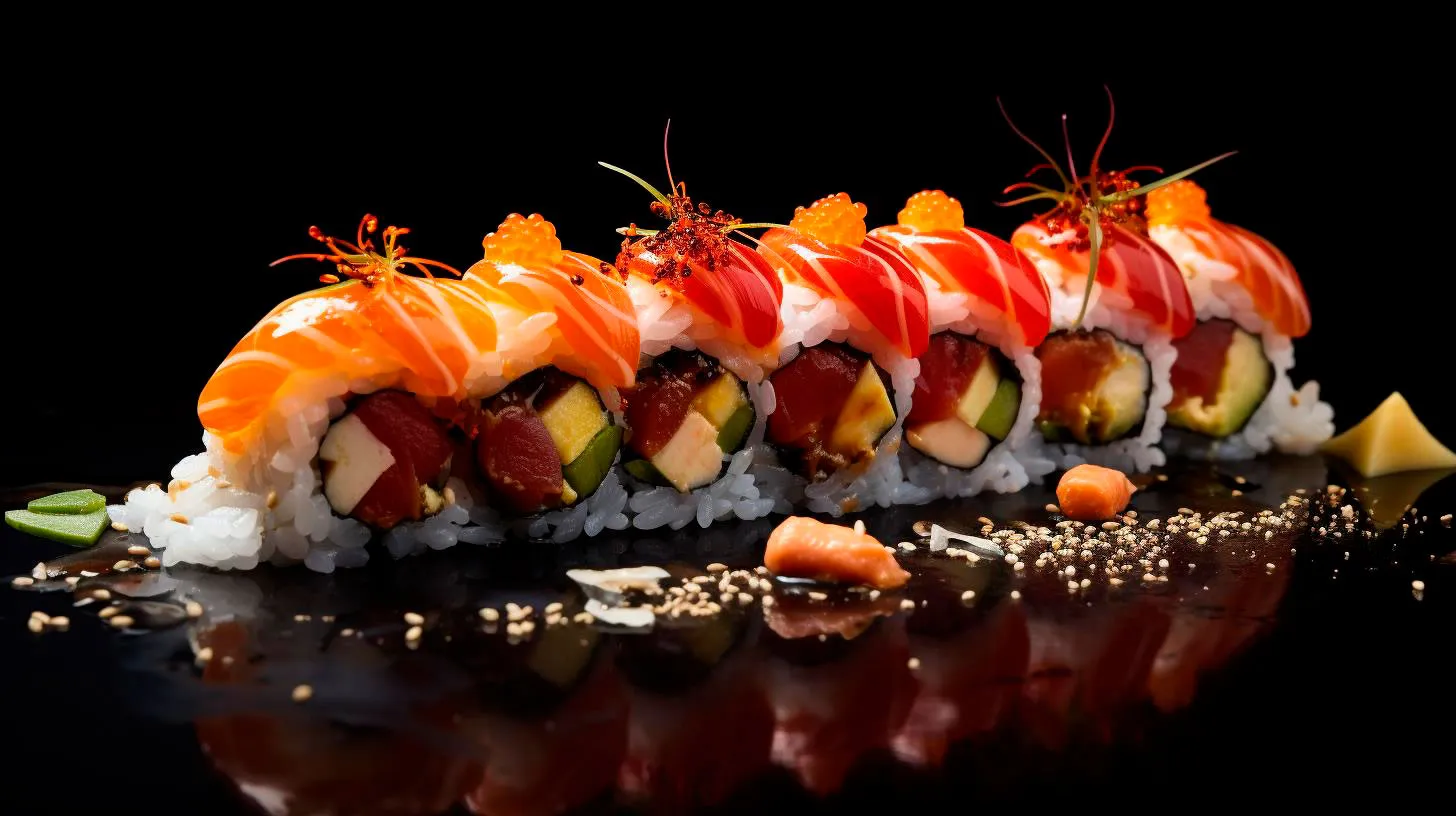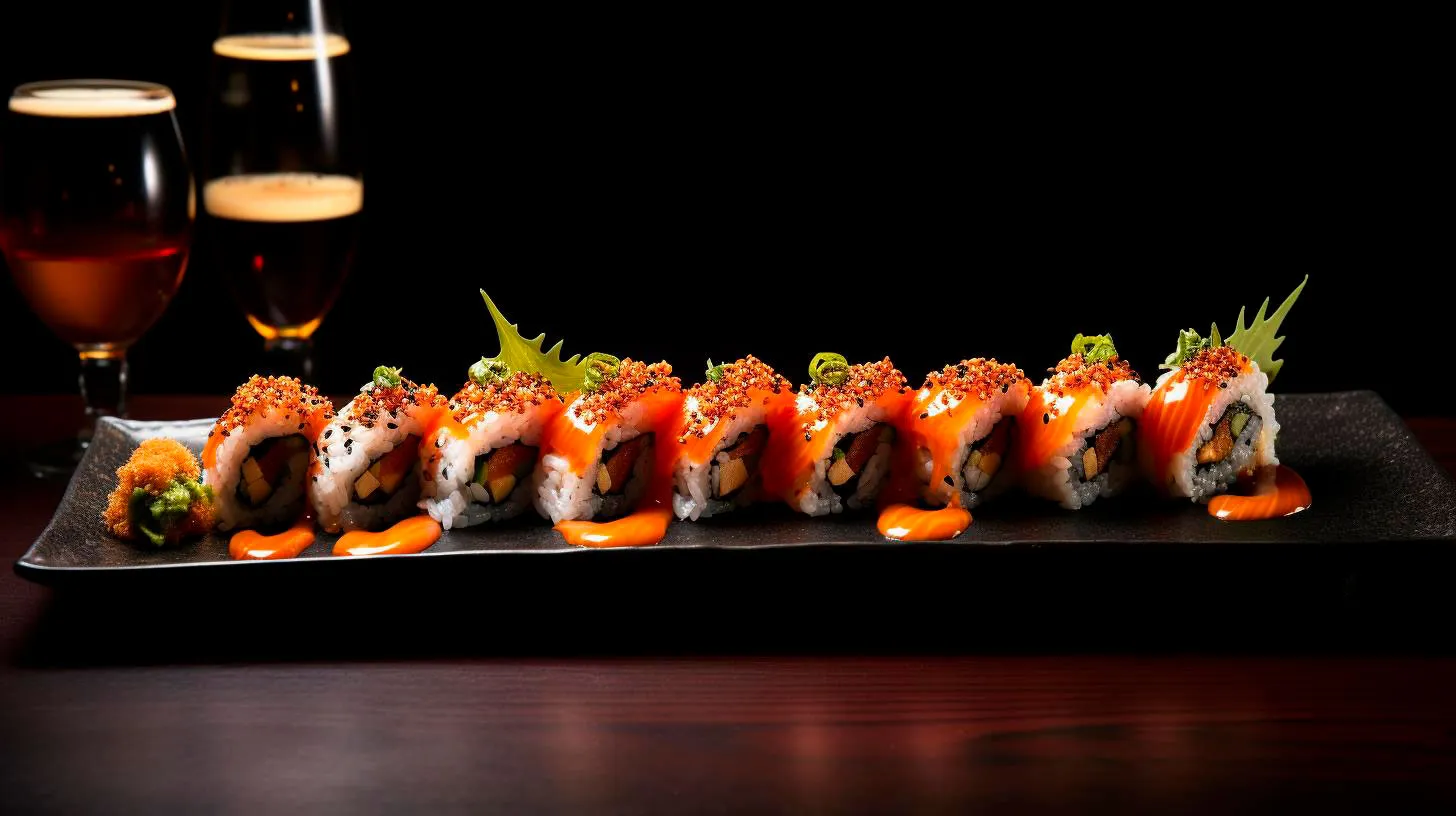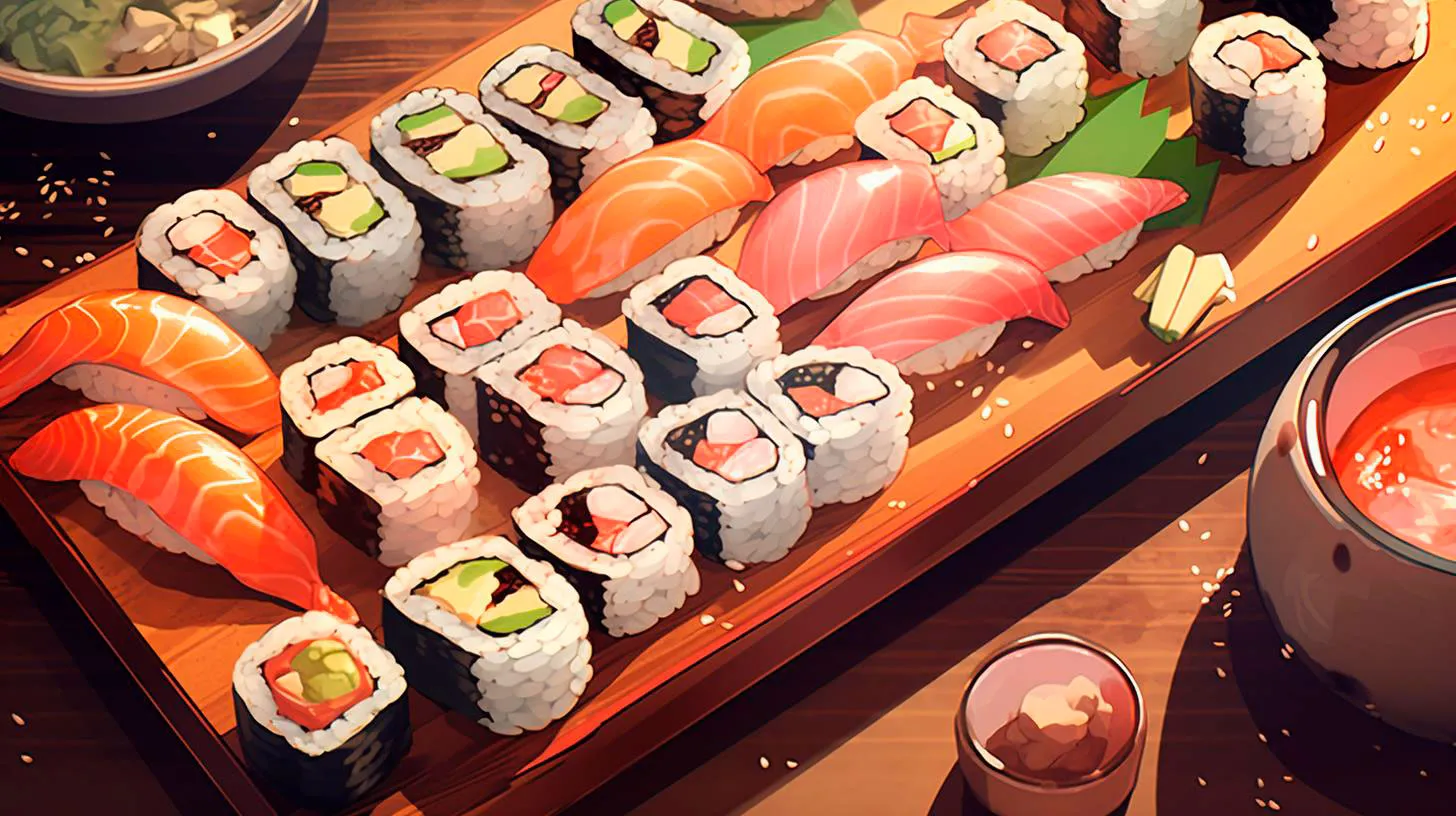Ensuring Your Sushi Safety: Understanding Food Handling Protocols
In this article, we will delve into the importance of proper food handling, highlight key safety measures, and provide tips on how to enjoy sushi without compromising your health.
The Importance of Proper Food Handling
Food handling protocols are crucial to minimize the risk of foodborne illnesses. Understanding and adhering to these practices can help prevent the growth of harmful bacteria, viruses, and parasites that can contaminate sushi. Neglecting food safety measures can lead to severe health consequences, such as food poisoning, gastrointestinal infections, and even life-threatening illnesses.
Here are some reasons why proper food handling is vital:
- Prevention of cross-contamination: Proper food handling techniques prevent the transfer of harmful pathogens from raw foods to cooked or ready-to-eat foods. This significantly reduces the risk of contamination and subsequent foodborne illnesses.
- Maintaining freshness: Sushi’s appeal lies in its freshness and delicate flavors. Adhering to food handling protocols ensures that sushi remains fresh and safe to consume.
- Regulatory compliance: Restaurants and food establishments must comply with stringent food safety regulations. By safely handling sushi, these establishments remain in good standing with regulatory bodies.
Key Safety Measures for Sushi Preparation
Now that we understand the significance of proper food handling, let’s explore some key safety measures that sushi chefs and restaurants follow to ensure sushi safety:
1. Sourcing High-Quality Ingredients
Quality ingredients are the foundation of safe and delicious sushi. Sushi chefs emphasize selecting fresh, high-grade fish and other seafood, ensuring they come from reputable suppliers with strict quality control standards.
2. Proper Fish Freezing Techniques
Freezing fish reduces the risk of parasitic infections such as anisakis. Sushi chefs freeze fish at temperatures below -20°C (-4°F) for a specific period to kill any potential parasites. This step is crucial, especially when using raw fish in sushi preparations.
3. Meticulous Sanitation Practices
Sanitization plays a vital role in preventing cross-contamination. Sushi chefs meticulously clean and sanitize their workstations, utensils, and equipment to eliminate any potential sources of contamination.
4. Thorough Fish Inspection
Sushi chefs must inspect fish thoroughly for any signs of spoilage or contamination before use. This inspection includes checking for discoloration, off-putting odors, and abnormal textures.
Safe Sushi Consumption Tips
While sushi restaurants and chefs bear the responsibility of upholding food handling protocols, as consumers, we can also take certain precautions to ensure our safety. Here are some tips:
- Choose reputable sushi restaurants: Opt for establishments with a good reputation for food safety to minimize potential risks.
- Observe cleanliness: Check if the restaurant maintains proper cleanliness and hygiene practices. Look for indicators like well-maintained facilities, clean restrooms, and attentive staff.
- Ask about ingredient sourcing: Inquire about the origin of the sushi ingredients, especially seafood. Responsibly sourced and handled ingredients are less likely to pose health risks.
- Be cautious with raw sushi: If you’re unsure about the freshness or quality of raw sushi, opt for cooked or vegetarian sushi options instead.
- Use trusted delivery services: If ordering sushi for delivery, ensure you choose reputable services that follow food safety regulations.
By following these tips, you can enjoy sushi without compromising your health and experience the flavors of this exquisite cuisine.
Key Takeaways
- Understanding and practicing proper food handling protocols is crucial for sushi safety.
- Safety measures such as sourcing high-quality ingredients, freezing fish appropriately, and maintaining meticulous sanitation practices are essential in sushi preparation.
- Consumers can contribute to their own safety by choosing reputable restaurants, observing cleanliness, and asking about ingredient sourcing.
Remember, sushi can be a delectable culinary experience, as long as it is prepared and handled properly. By prioritizing food safety and adhering to the recommended protocols, you can enjoy sushi with peace of mind – savoring every bite without worrying about compromising your well-being.
Clearing Up Sushi Myths: Debunking Common Misconceptions
Myth 1: Sushi means raw fish
Contrary to popular belief, sushi does not solely mean raw fish. Sushi actually refers to vinegared rice, which is often combined with various ingredients, including raw or cooked seafood, vegetables, and even fruits. The term “sashimi” is used for slices of raw fish or seafood, which are sometimes served alongside sushi.
Key Takeaway: Sushi is a broad term that encompasses much more than just raw fish. It is primarily about the skilled preparation and presentation of vinegared rice.
Myth 2: Sushi is always expensive
While sushi can indeed be a luxurious dining experience, it doesn’t mean that it is always expensive. In Japan, you can find affordable sushi options at conveyor belt or standing sushi bars, where sushi plates are priced reasonably. This concept has also gained popularity in many other countries, offering more affordable options for sushi lovers.
Key Takeaway: Sushi can fit a range of budgets, from high-end restaurants to more casual establishments, making it accessible to a wider audience.
Myth 3: Sushi is only eaten with chopsticks
While it is common to see people using chopsticks when eating sushi, it is not the only way to enjoy this delicacy. In fact, sushi can be eaten with your hands, especially when pieces are small enough to be consumed in one bite. Japanese sushi chefs often eat nigiri sushi with their hands to maintain its delicate shape when serving guests.
Key Takeaway: It’s perfectly acceptable to eat sushi with either chopsticks or your hands, depending on personal preference and the type of sushi being enjoyed.
Myth 4: All sushi contains raw fish
While raw fish is a popular ingredient in many sushi preparations, not all sushi contains raw fish. Sushi can feature a variety of ingredients, such as cooked seafood, vegetables, or even tofu. Vegetarian options like cucumber rolls, avocado rolls, or vegetable tempura sushi are delicious alternatives for those who prefer to avoid raw fish.
Key Takeaway: Sushi offers a wide array of options beyond raw fish, ensuring there is something for everyone’s palate.
Myth 5: Sushi should be dipped in soy sauce fish-side down
It is a common belief that when dipping sushi in soy sauce, you should dip it with the fish side down. However, this misconception can lead to the fish becoming oversaturated with soy sauce, overwhelming the delicate flavor balance of the sushi. Instead, it is recommended to dip the sushi gently into the soy sauce fish-side up, allowing a moment to absorb just the right amount of flavor.
Key Takeaway: To fully savor the flavors of sushi, dip it delicately fish-side up into soy sauce to enhance the overall taste experience.
Myth 6: Sushi is only served with wasabi
Wasabi, a spicy green paste, is often associated with sushi, adding a distinctive kick to each bite. However, not all sushi is served with wasabi as it can overpower more delicate flavors. In traditional sushi bars, the chef may apply the appropriate amount of wasabi to each piece before serving, ensuring a harmonious balance between the ingredients.
Key Takeaway: While wasabi is common, not all sushi is served with this condiment. Trust the chef’s expertise in creating the perfect flavor combination.
Myth 7: Sushi must be completely filled with fish
Contrary to the belief that sushi must be filled to the brim with fish, the most exquisite sushi showcases the artistry of balance. The proportion of rice to fish is crucial in creating the perfect sushi bite. When prepared by skilled sushi chefs, the delicate combination of flavors is achieved by ensuring the rice and fish harmonize seamlessly.
Key Takeaway: True sushi artistry lies in achieving an ideal balance of rice and fish, showcasing the chef’s mastery in creating an unforgettable culinary experience.
In Conclusion
Sushi, a culinary delight that goes beyond raw fish, offers a multitude of options for everyone’s taste preferences. Understanding the truth behind common sushi misconceptions allows us to fully appreciate the artistry, variety, and accessibility of this Japanese cuisine.
From Ocean to Plate: Tracing the Journey of Your Sushi
The Origins of Sushi
Before we delve into the journey of your sushi, let’s take a moment to appreciate its humble beginnings. Sushi can be traced back to Southeast Asia, where it was initially developed as a method of preserving fish by fermenting it with rice. Over time, this simple preservation method evolved into the delicious and artistic dish we know and love today.
Sushi gained prominence in Japan during the Edo period, when it transformed into fresh fish and rice served without fermentation. Initially consumed as street food, sushi eventually became a staple in Japanese cuisine and spread across the globe. Today, sushi has evolved into various types, catering to the diverse tastes and preferences of sushi enthusiasts worldwide.
From the Ocean to Your Plate: The Journey Begins
The journey of your sushi starts in the vast oceans, where skilled fishermen venture out in search of the finest seafood. These fishermen employ traditional techniques passed down through generations, ensuring sustainable fishing practices and minimal impact on marine life. Freshness is the key when it comes to sushi, and the best catch is selected with utmost care.
Once the fish is caught, it is immediately cleaned and transported to local fish markets. These bustling markets serve as a hub for sushi-grade fish, attracting sushi chefs and wholesalers alike. Here, the fish is carefully inspected, graded, and sold to sushi restaurants or other seafood distributors who will handle the next stages of the journey.
Behind the Scenes: Sushi Wholesalers and Sushi Restaurants
Once the fish reaches wholesalers, it undergoes another round of rigorous inspections to ensure the highest quality and safety standards. These professionals have a keen eye for selecting the best fish, rejecting any that do not meet their strict criteria. The selected fish are then processed, cleaned, and prepared for transport to their final destination.
Sushi restaurants are the ultimate destination for your favorite sushi delicacies. They work closely with wholesalers to source the freshest ingredients, including fish, rice, and other essential components. Sushi chefs, renowned for their culinary expertise, create masterpieces using their intricate knife skills, precision, and attention to detail.
Mastering the Art of Sushi Preparation
Preparing sushi is an art form that requires years of practice and dedication. Sushi chefs meticulously handle each ingredient, ensuring it is cut to the perfect size, seasoned with precision, and expertly rolled or assembled. They combine traditional techniques with contemporary flavors, offering a fusion of innovation and tradition on your plate.
Quality is paramount in sushi preparation. Chefs take pride in using the freshest fish, sourced from trusted suppliers who follow sustainable fishing practices. They also pay attention to the rice, as its flavor, texture, and consistency greatly impact the overall taste of the sushi. The perfect sushi should tantalize your taste buds with a delicate balance of flavors and textures, leaving you craving for more.
Key Takeaways: The Journey Unveiled
- Sushi originated in Southeast Asia as a preservation method for fish.
- Sushi gained prominence in Japan during the Edo period and quickly became a celebrated dish worldwide.
- The journey of your sushi starts with skilled fishermen who employ sustainable fishing practices.
- Local fish markets serve as hubs for sushi-grade fish, ensuring freshness and quality.
- Wholesalers rigorously inspect and process the fish before distributing it to sushi restaurants.
- Sushi chefs masterfully prepare each piece, using fresh ingredients and traditional techniques.
- The art of sushi preparation requires precision, attention to detail, and a deep understanding of flavor combinations.
Next time you sit down to enjoy a plate of sushi, take a moment to appreciate the incredible journey it undertook to reach your table. From the skillful hands of fishermen to the expertise of sushi chefs, this iconic dish embodies the essence of tradition, innovation, and a love for exceptional cuisine. Bon appétit!
Mastering Sushi Etiquette: Properly Enjoying this Japanese Delicacy
In this article, we will explore the art of mastering sushi etiquette, ensuring that you fully enjoy your next sushi adventure.
The Importance of Sushi Etiquette
Sushi etiquette is not just a set of rules; it reflects Japan’s rich cultural heritage, respect for tradition, and appreciation for the culinary experience. By adhering to proper sushi etiquette, you not only showcase your respect for the craft, but you also enhance your overall dining experience and gain the respect of your fellow diners and sushi chefs.
Key Takeaways:
- Proper sushi etiquette reflects Japan’s cultural heritage and respect for tradition.
- Adhering to etiquette enhances your dining experience and gains respect from others.
The Dos and Don’ts of Sushi Etiquette
1. Using Chopsticks
When using chopsticks, it is crucial to remember a few etiquette guidelines:
- Do use chopsticks to pick up sushi pieces or sashimi. It is the traditional way to enjoy sushi.
- Don’t use chopsticks to pass food to someone else’s chopsticks directly. Instead, place it on their plate.
- Do rest your chopsticks on the provided chopstick rest when not in use. Never stick them upright in your rice bowl as it resembles a funeral ritual.
- Don’t use chopsticks to gesture or point at something.
2. Soy Sauce and Wasabi
Proper usage of soy sauce and wasabi is essential to maintain the delicate flavors of sushi:
- Do pour a small amount of soy sauce into the soy dish provided. Refrain from wasting soy sauce as it can be disrespectful.
- Don’t mix wasabi directly into the soy sauce. Instead, apply a small amount of wasabi directly to your sushi piece if desired.
- Do dip your sushi piece lightly into soy sauce, fish-side down. Avoid soaking the rice in soy sauce as it can overpower the flavors.
- Don’t double-dip your sushi into soy sauce, as it is considered unhygienic.
3. Eating Sushi
Knowing how to consume sushi properly demonstrates your appreciation for the artistry behind it:
- Do eat sushi in one bite whenever possible, to experience the perfect combination of flavors and textures created by the chef.
- Don’t separate the ingredients from the sushi piece or pick off toppings you dislike. Trust the chef’s expertise.
- Do eat sushi with your fingers if you feel comfortable doing so. It is perfectly acceptable in sushi establishments.
- Don’t rub your chopsticks together, as it can imply that they are of poor quality.
4. Interacting with the Sushi Chef
Building a good rapport with the sushi chef can enhance your experience further:
- Do greet the sushi chef with a polite greeting, such as “Konbanwa” (Good evening) upon entering the sushi bar or restaurant.
- Don’t engage in loud conversations or disruptive behavior that may disturb other customers or distract the chef’s concentration.
- Do ask the chef for recommendations or suggestions if you are unsure about certain types of sushi.
- Don’t use your cell phone at the sushi counter unless it is necessary. It can be considered impolite and disrespectful.
Appreciating Sushi: A Cultural Journey
Sushi etiquette is not just about following rules; it is about immersing yourself in a cultural experience. By understanding and respecting the traditions associated with sushi, you gain a deeper appreciation for the craftsmanship, unique flavors, and history behind each sushi piece.
So next time you savor the delicate flavors of sushi, remember to master sushi etiquette. By doing so, you elevate your dining experience, demonstrate respect for Japanese culture, and create lasting memories. Enjoy your journey into the world of sushi, the Japanese culinary treasure!



